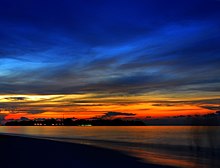The Maldives consists of approximately 1,190 coral islands grouped in a double chain of 26 atolls, along the north-south direction, spread over roughly 90,000 square kilometres, making this one of the most dispersed countries in the world. It lies between latitudes 1°S and 8°N, and longitudes 72° and 74°E. The atolls are composed of live coral reefs and sand bars, situated atop a submarine ridge 960 kilometres long that rises abruptly from the depths of the Indian Ocean and runs from north to south. Only near the southern end of this natural coral barricade do two open passages permit safe ship navigation from one side of the Indian Ocean to the other through the territorial waters of Maldives. For administrative purposes the Maldivian government organized these atolls into twenty one administrative divisions. The largest island of Maldives is Gan, which belongs to Laamu Atoll or Hahdhummathi Maldives. In Addu Atoll the westernmost islands are connected by roads over the reef and the total length of the road is 14 km (9 mi).
The Maldives is the lowest country in the world, with a maximum natural ground level of only 2.3 metres (7 ft 7 in), with the average being only 1.5 metres (4 ft 11 in) above sea level, although in areas where construction exists, this has been increased to several metres. More than 80 per cent of the country's land, composed of coral islands scattered over an area about 850 km across the equator, is less than one metre above sea level.[18]
The reef is composed of coral debris and living coral. This acts as a natural barrier against the sea, forming lagoons. Other islands, set at a distance and parallel to the reef, have their own protective fringe of reef. An opening in the surrounding coral barrier allows access to the calmer lagoon waters. The barrier reefs of the islands protect them from the storms and high waves of the Indian Ocean.
The limited vegetation and land wildlife is supplemented by the abundance of marine life. The waters around the Maldives are abundant in rare species of biological and commercial value, with tuna fisheries being traditionally one of the main commercial resources of the country. The Maldives have an amazing diversity of sea life, with corals and over 2,000 species of fish, ranging from reef fish to reef sharks, moray eels, and a wide variety of rays: Manta rays; Stingray; and Eagle ray. The Maldivian waters are also home for the whale shark.
And if that's not enough. Just check out the climate.
Climate
The Indian Ocean has a great effect on the climate of the country by acting as a heat buffer, absorbing, storing, and slowly releasing the tropical heat. The temperature of Maldives ranges between 24 °C (75 °F) and 33 °C (91 °F) throughout the year. Although the humidity is relatively high, the constant cool sea breezes keep the air moving and the heat mitigated.
The weather in the Maldives is affected by the large landmass of South Asia to the north. The presence of this landmass causes differential heating of land and water. These factors set off a rush of moisture-rich air from the Indian Ocean over South Asia, resulting in the southwest monsoon. Two seasons dominate Maldives' weather: the dry season associated with the winter northeastern monsoon and the rainy season which brings strong winds and storms. The shift from the moist southwest monsoon to the dry northeast monsoon occurs during April and May. During this period, the northeast winds contribute to the formation of the northeast monsoon, which reaches Maldives in the beginning of June and lasts until the end of August. However, the weather patterns of Maldives do not always conform to the monsoon patterns of South Asia. The annual rainfall averages 2,540 millimetres in the north and 3,810 millimetres in the south.There are multiple reasons for wanting to travel to the Maldives. Here are a few more.





No comments:
Post a Comment